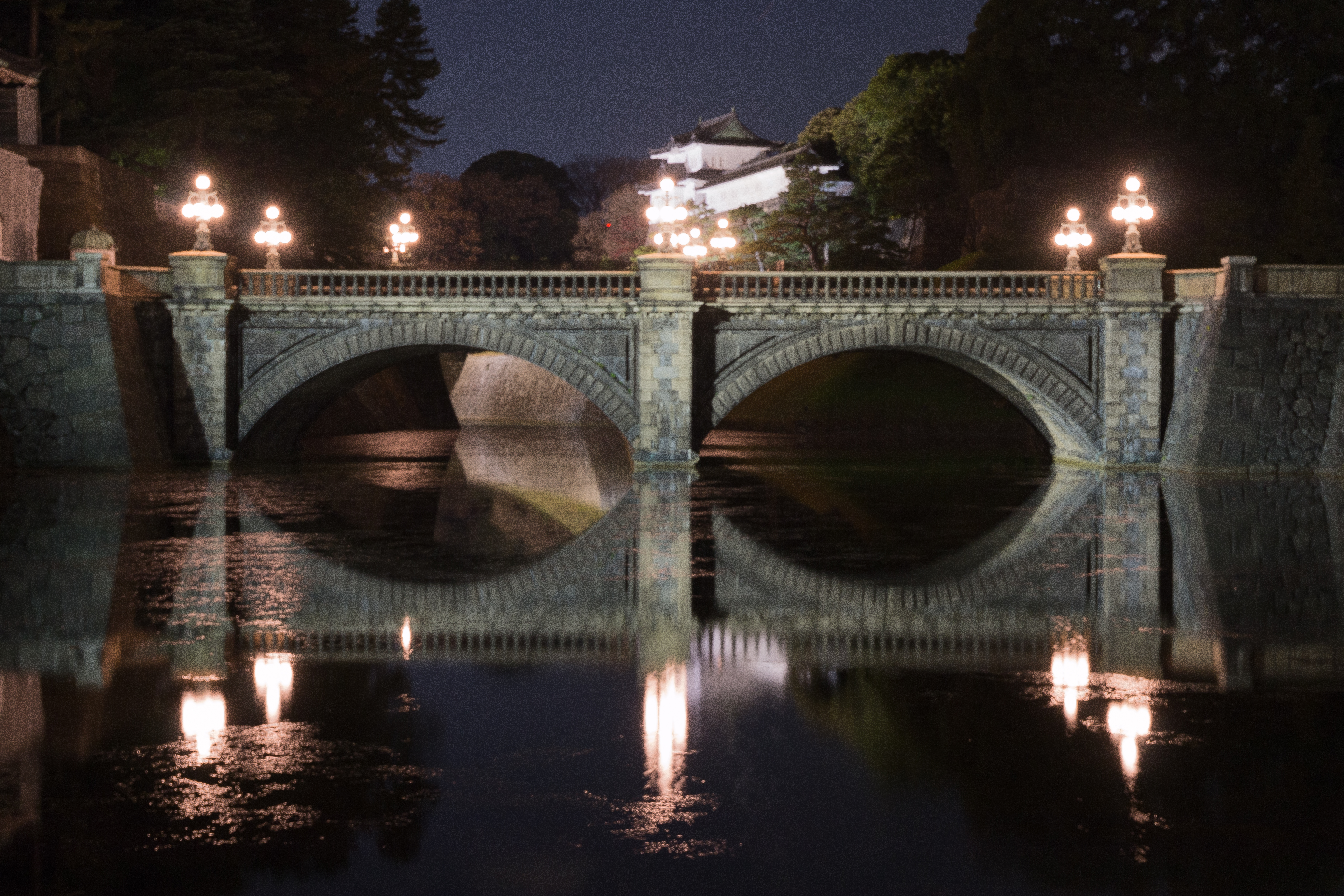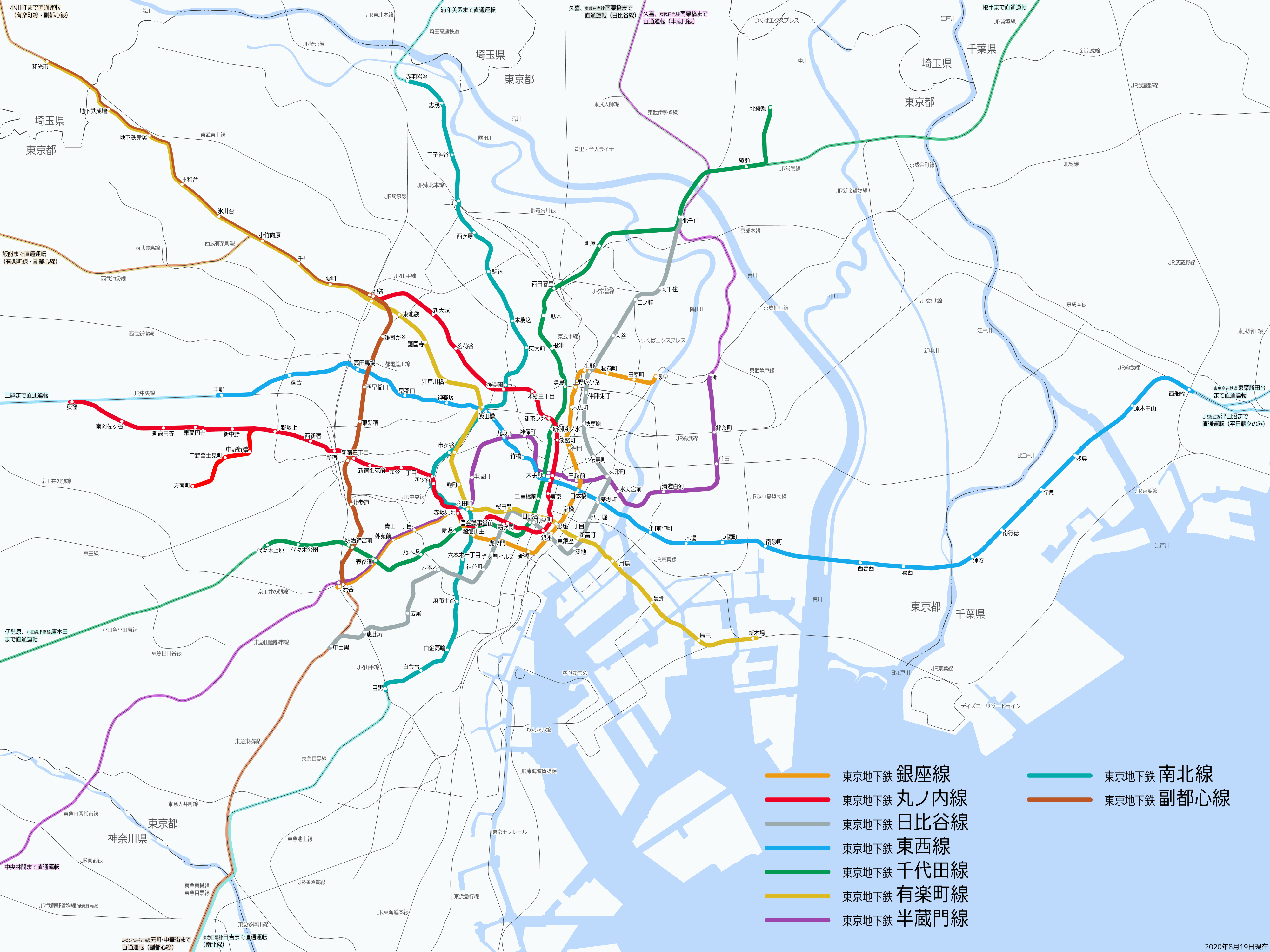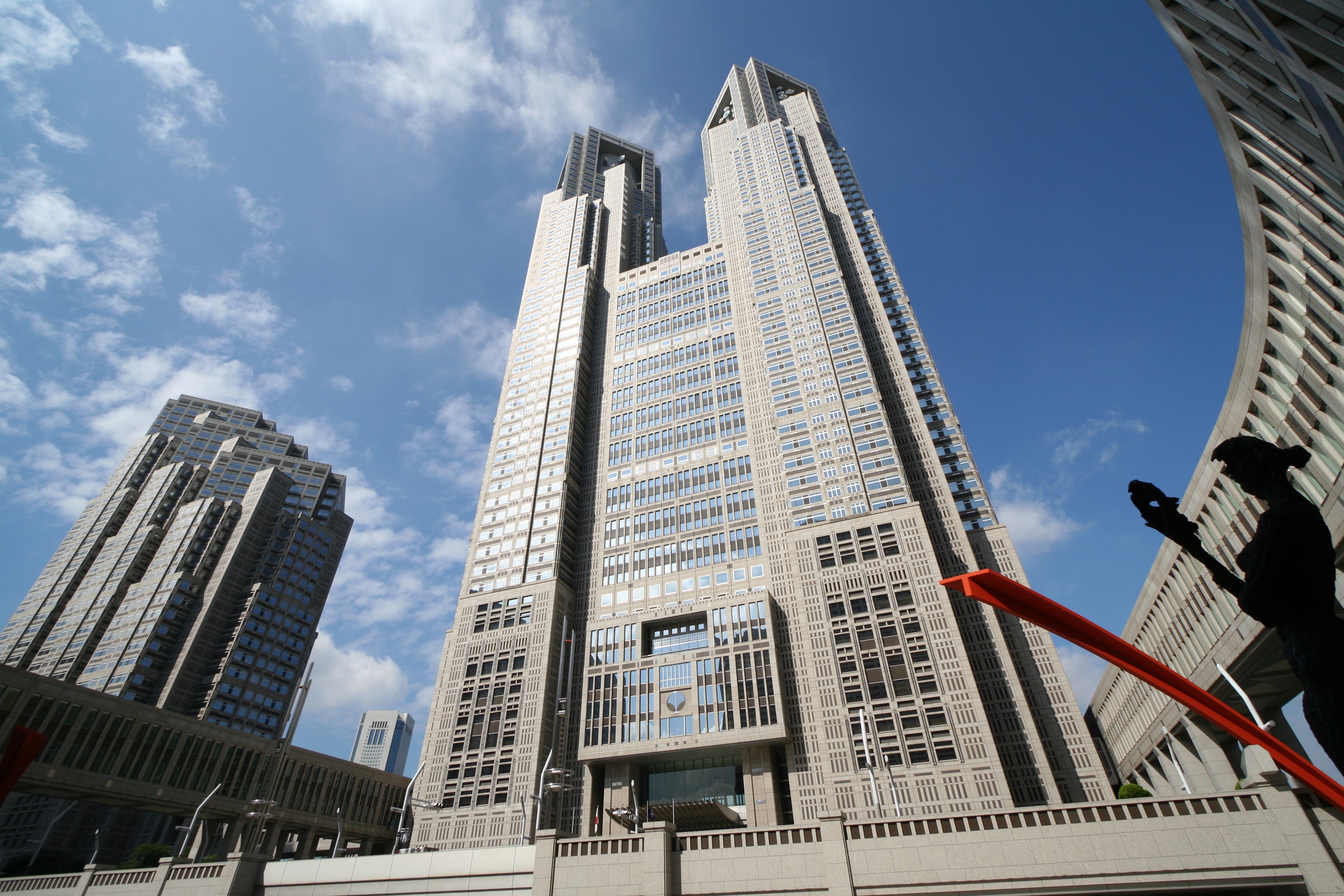|
Hanzōmon Station
is a subway station on the Tokyo Metro Hanzōmon Line in Chiyoda, Tokyo, Japan, operated by the Tokyo subway operator Tokyo Metro. It is located near the Hanzōmon Gate of the Imperial Palace. The station was the eastern terminal of the Hanzōmon Line from 1982 to 1989 and is still used as a terminal for some morning rush hour trains. It is the only station on the Hanzōmon Line not to connect with any other subway or railway lines; however, it is a five-minute walk from Kōjimachi Station on the Tokyo Metro Yurakucho Line. Station layout History The station opened on 9 December 1982. The station facilities were inherited by Tokyo Metro The is a major rapid transit system in Tokyo, Japan, operated by the Tokyo Metro Co. With an average daily ridership of 6.84 million passengers, the Tokyo Metro is the larger of the two subway operators in the city; the other being the Toei ... after the privatization of the Teito Rapid Transit Authority (TRTA) in 2004. Reference ... [...More Info...] [...Related Items...] OR: [Wikipedia] [Google] [Baidu] |
Chiyoda, Tokyo
is a special ward located in central Tokyo, Japan. It is known as Chiyoda City in English.Profile ." ''City of Chiyoda''. Retrieved on December 28, 2008. It was formed in 1947 as a merger of and wards following 's transformation into Tokyo Metropolis. The modern Chiyoda ward exhibits contrasting |
Tokyo
Tokyo (; ja, 東京, , ), officially the Tokyo Metropolis ( ja, 東京都, label=none, ), is the capital and largest city of Japan. Formerly known as Edo, its metropolitan area () is the most populous in the world, with an estimated 37.468 million residents ; the city proper has a population of 13.99 million people. Located at the head of Tokyo Bay, the prefecture forms part of the Kantō region on the central coast of Honshu, Japan's largest island. Tokyo serves as Japan's economic center and is the seat of both the Japanese government and the Emperor of Japan. Originally a fishing village named Edo, the city became politically prominent in 1603, when it became the seat of the Tokugawa shogunate. By the mid-18th century, Edo was one of the most populous cities in the world with a population of over one million people. Following the Meiji Restoration of 1868, the imperial capital in Kyoto was moved to Edo, which was renamed "Tokyo" (). Tokyo was devastate ... [...More Info...] [...Related Items...] OR: [Wikipedia] [Google] [Baidu] |
Japan
Japan ( ja, 日本, or , and formally , ''Nihonkoku'') is an island country in East Asia. It is situated in the northwest Pacific Ocean, and is bordered on the west by the Sea of Japan, while extending from the Sea of Okhotsk in the north toward the East China Sea, Philippine Sea, and Taiwan in the south. Japan is a part of the Ring of Fire, and spans Japanese archipelago, an archipelago of List of islands of Japan, 6852 islands covering ; the five main islands are Hokkaido, Honshu (the "mainland"), Shikoku, Kyushu, and Okinawa Island, Okinawa. Tokyo is the Capital of Japan, nation's capital and largest city, followed by Yokohama, Osaka, Nagoya, Sapporo, Fukuoka, Kobe, and Kyoto. Japan is the List of countries and dependencies by population, eleventh most populous country in the world, as well as one of the List of countries and dependencies by population density, most densely populated and Urbanization by country, urbanized. About three-fourths of Geography of Japan, the c ... [...More Info...] [...Related Items...] OR: [Wikipedia] [Google] [Baidu] |
Island Platform
An island platform (also center platform, centre platform) is a station layout arrangement where a single platform is positioned between two tracks within a railway station, tram stop or transitway interchange. Island platforms are popular on twin-track routes due to pragmatic and cost reasons. They are also useful within larger stations where local and express services for the same direction of travel can be provided from opposite sides of the same platform thereby simplifying transfers between the two tracks. An alternative arrangement is to position side platforms on either side of the tracks. The historical use of island platforms depends greatly upon the location. In the United Kingdom the use of island platforms is relatively common when the railway line is in a cutting or raised on an embankment, as this makes it easier to provide access to the platform without walking across the tracks. Advantages and tradeoffs Island platforms are necessary for any station with many th ... [...More Info...] [...Related Items...] OR: [Wikipedia] [Google] [Baidu] |
Tokyo Metro Hanzōmon Line
The is a subway line in Tokyo, Japan, owned and operated by Tokyo Metro. Overview The 16.8 km line serves the wards of Shibuya, Minato, Chiyoda, Chūō, Kōtō, and Sumida. Despite being shorter in length than nearly all other Tokyo subway lines, the Hanzōmon Line operates some of the longest through services with private railways – namely Tōkyū Corporation and Tobu Railway. The line is connected to Tōkyū Den-en-toshi Line at Shibuya Station to the south, and to the Tobu Skytree Line at to the north. Through trains operate between on the Tōkyū Den-en-toshi Line and on the Tobu Skytree Line, onward to on the Tobu Isesaki Line and on the Tobu Nikko Line.Tobu Timetable, 16 March 2013, p.168-176 Through-service trains between Chūō-Rinkan and Minami-Kurihashi cover a total distance of 98.5 km in a single run – nearly six times the length of the Hanzōmon Line alone. The Hanzōmon Line has direct interchanges with all other Tokyo Metro and Toei lines. ... [...More Info...] [...Related Items...] OR: [Wikipedia] [Google] [Baidu] |
Tokyo Metro
The is a major rapid transit system in Tokyo, Japan, operated by the Tokyo Metro Co. With an average daily ridership of 6.84 million passengers, the Tokyo Metro is the larger of the two subway operators in the city; the other being the Toei Subway, with 2.85 million average daily rides. Organization Tokyo Metro is operated by , a joint-stock company jointly owned by the Government of Japan and the Tokyo Metropolitan Government. The company, founded as a part of then-Prime Minister Junichiro Koizumi's policy of converting statutory corporations into joint-stock companies, replaced the , commonly known as Eidan or TRTA, on April 1, 2004. TRTA was administered by the Ministry of Land, Infrastructure and Transport, and jointly funded by the national and metropolitan governments. It was formed in 1941 as a part-nationalization of the Tokyo Underground Railway and Tokyo Rapid Railway (now both form the Tokyo Metro Ginza Line), although its oldest lines date back to 1927 with th ... [...More Info...] [...Related Items...] OR: [Wikipedia] [Google] [Baidu] |
Kokyo
The is the main residence of the Emperor of Japan. It is a large park-like area located in the Chiyoda district of the Chiyoda ward of Tokyo and contains several buildings including the where the Emperor has his living quarters, the where various ceremonies and receptions take place, some residences of the Imperial Family, an archive, museums and administrative offices. It is built on the site of the old Edo Castle. The total area including the gardens is . During the height of the 1980s Japanese property bubble, the palace grounds were valued by some to be more than the value of all of the real estate in the U.S. state of California. History Edo castle After the capitulation of the shogunate and the Meiji Restoration, the inhabitants, including the Shōgun Tokugawa Yoshinobu, were required to vacate the premises of the Edo Castle. Leaving the Kyoto Imperial Palace on 26 November 1868, the Emperor arrived at the Edo Castle, made it to his new residence and renamed it ... [...More Info...] [...Related Items...] OR: [Wikipedia] [Google] [Baidu] |
Kōjimachi Station
is a subway station on the Tokyo Metro Yurakucho Line in the Kōjimachi neighborhood of Chiyoda, Tokyo, Japan, operated by the Tokyo Subway operator Tokyo Metro. Its station number is Y-15. Lines Kōjimachi Station is served by the Tokyo Metro Yūrakuchō Line. Station layout History The station opened on 30 October 1974. Passenger statistics An average of 54,889 passengers used this station daily in fiscal 2006. See also *List of railway stations in Japan
The links below contain all of the 8579 railway stations in Japan.
Exter ...
[...More Info...] [...Related Items...] OR: [Wikipedia] [Google] [Baidu] |
Tokyo Metro Yurakucho Line
Tokyo (; ja, 東京, , ), officially the Tokyo Metropolis ( ja, 東京都, label=none, ), is the capital and largest city of Japan. Formerly known as Edo, its metropolitan area () is the most populous in the world, with an estimated 37.468 million residents ; the city proper has a population of 13.99 million people. Located at the head of Tokyo Bay, the prefecture forms part of the Kantō region on the central coast of Honshu, Japan's largest island. Tokyo serves as Japan's economic center and is the seat of both the Japanese government and the Emperor of Japan. Originally a fishing village named Edo, the city became politically prominent in 1603, when it became the seat of the Tokugawa shogunate. By the mid-18th century, Edo was one of the most populous cities in the world with a population of over one million people. Following the Meiji Restoration of 1868, the imperial capital in Kyoto was moved to Edo, which was renamed "Tokyo" (). Tokyo was devastated ... [...More Info...] [...Related Items...] OR: [Wikipedia] [Google] [Baidu] |
Tobu Skytree Line
The is a section of the Tobu Isesaki line operated by the private railway company Tobu Railway, extending from Asakusa Station in Tokyo to Tōbu-Dōbutsu-Kōen Station in Saitama Prefecture. Some trains from the line continue to the Tokyo Metro Hibiya Line and Tokyo Metro Hanzōmon Line. This section was branded the Tobu Skytree Line on 17 March 2012 in conjunction with the opening of the Tokyo Skytree tower (which Tobu Railway owns). However, in through services with the Hibiya line, the Tobu SkyTree Line actually does not stop anywhere near the Tokyo SkyTree. Description ;Track: :Quadruple: − 1.3 km, − 18.9 km :Double: Rest of the line Note that Oshiage Station is officially an extension or part of Tokyo Skytree. The double tracks between Oshiage and Hikifune are thus the third and fourth tracks of the Tokyo Skytree − Hikifune section. Operation All-stations "Local" services operate from to , and , and onward to on the Tōbu Nikkō Line.Tobu Timetable, 16 March ... [...More Info...] [...Related Items...] OR: [Wikipedia] [Google] [Baidu] |
Tobu Isesaki Line
The is a Japanese railway line operated by the private railway company Tobu Railway, extending from Tōbu-Dōbutsu-Kōen Station in Saitama to Isesaki Station in Gunma Prefecture. The Isesaki Line can refer to the entire section between Asakusa - Isesaki and Oshiage - Hikifune, but from March 2012, the 41.0 km section south of Tōbu-Dōbutsu-Kōen was branded as the Tobu Skytree Line in conjunction with the opening of the Tokyo Skytree tower. Descriptions ;Track: :single: − 39.9 km :double: the rest Operation Service patterns Stops and operated sections are as of 2017. ; (announced as or for short) :*Tōbu-Dōbutsu-Kōen − Ōta. Connection with Express. Three per hour, with one between Kuki and Tatebayashi. :*Ōta − Isesaki. One per hour per direction, conductorless. ; :Between Asakusa and Tōbu-Dōbutsu Kōen, Kuki or Minami-Kurihashi on Nikkō Line. ; :Early morning and late night. Down to Tōbu-Dōbutsu-Kōen, Kuki or to Minami-Kurihashi on the Nikkō Li ... [...More Info...] [...Related Items...] OR: [Wikipedia] [Google] [Baidu] |








